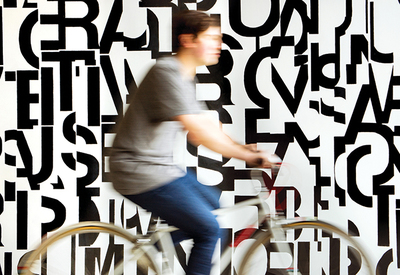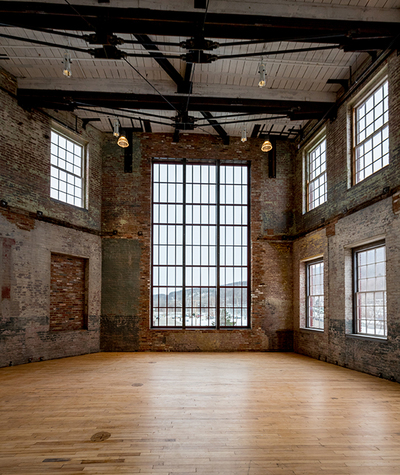MASS MoCA’s Building 6 Opens!

Mary Lum, Assembly (Lorem Ipsum), 2017, exterior house paint, mirror, site-specific dimensions. Courtesy of the artist. Photo: Jason Reinhold.
The art-rich swath of the Berkshires bracketed by Williamstown and North Adams is amplifying its profile this summer with a major expansion at MASS MoCA and an alliance of cultural institutions intent on bringing more visibility to the region.
The $65.4 million MASS MoCA renovation more than doubles the indoor space available for art, while its alliance with the Clark Art Institute, the Williams College Museum of Art, the Bennington (VT) Museum and the Williamstown Theatre Festival cements their informal resource sharing into a unified initiative. Called “ArtCountry,” the consortium will capitalize on the region’s reputation for exceptional art in a rural locality where cultural assets of such magnitude are rare.
Marquee names on the art scene this summer include Pablo Picasso, James Turrell, Robert Rauschenberg, Jenny Holzer, Laurie Anderson, Helen Frankenthaler, even Grandma Moses. Picasso and Frankenthaler are at the Clark. The Bennington Museum has a modern take on Grandma Moses (Anna Mary Robertson Moses, 1860–1961), who lived in nearby Eagle Bridge, NY. The others are at MASS MoCA, which opened 16 shows on May 28 in one of New England’s top summer art events.
The audience-building integration of the arts promoted by ArtCountry is already a given at many museums, but nowhere more than at MASS MoCA. With no permanent collection, the museum acts as a laboratory for new work in music, theater and dance as well as visual art. Its annual Solid Sound, Bang on a Can and Fresh Grass music festivals draw thousands of fans to North Adams, and its residencies and workshops nurture emerging and established talent.
The deft redesign of wedge-shaped Building 6, the museum’s long-vacant, westernmost extension, by Cambridge architects Bruner/Cott & Associates, acknowledges that trend and brings to a climax two decades of incremental expansion the firm has overseen. Besides exhibition space, it provides backstage facilities for concerts and art storage and completes a circuit that allows viewers to tour galleries without retracing their steps.
More noticeably, it departs from the railroad-style sequencing of enclosed galleries prevalent in the rest of the museum to one that “floats” them within the open gridscape. That approach shifts the galleries toward the center of the building footprint and allows natural light to flood the wide corridors around the perimeter.

New construction, Building 6 at MASS MoCA, North Adams, MA. Photo: Douglas Mason.
Much of the new space houses long-term installations by Turrell, Holzer, Rauschenberg and Anderson, as well as Louise Bourgeois and Gunnar Schonbeck. MASS MoCA pioneered the practice of partnering with such artists to display artworks too unwieldy for conventional galleries. Massive wall drawings by Sol LeWitt and large-scale sculptures and paintings by Anselm Kiefer occupy other campus locations.
Director Joseph Thompson describes it as “co-development” with artists the museum has held in long-standing relationships. The museum provides the space and the artists or their foundations or estates provide the art. Installations are long term (about 20 years) rather than permanent, he says, to allow for revisionist thinking.
The challenge Bruner/Cott faced was to customize spaces for these key artists while clarifying visitor-circulation patterns and enlivening three floors of nearly identical loft acreage. They did it by creating what founding partner Simeon Bruner called “museums within the museum”—dedicated spaces for each artist.
To preserve MASS MoCA’s signature, raw industrial look, the architects had 5,000 bricks and 60,000 square feet of maple flooring taken up, cleaned and reused. Thick floors were cut through to gain height and visual drama in some areas and an interior light well, filled with patchwork construction, was converted into a 20-by-140-foot atrium. Finished in rough stone and brick and pierced by shafts of sunlight, the two-story atrium acts as a linear hub from which visitors can orient themselves.
To open up space, the architects used structural steel supports to reduce the dense grid of posts holding up the floors. Wide perimeter corridors allow visitors to look out over the cityscape or into the skylit atrium.
The journey through the reconfigured museum climaxes in a spectacular, prow-shaped public space overlooking the confluence of the north and south branches of the Hoosic River. Designed as a spot to congregate or rest and contemplate, it is a sublime intersection of art, architecture and nature.
The long-term installations are spread over three floors. Turrell’s nine immersive light and space environments, representing the range of his career, are instant catnip. Clustered around a two-story courtyard and entered through darkened passages, each one—big, small and variously shaped—glows with projected light cast in ways that create optical illusions of distance and boundaries and leaves one unsure of what is real and what isn’t.
Holzer’s cumulatively disturbing array of enlarged, wall-mounted copies of government communications obtained through the Freedom of Information Act, shed light on the individual abuses and human casualties of recent American military adventures. Tables of actual human bones, artfully arranged, signify the fragility of human life and the finality of death.
Performance artist/composer Anderson called upon her drafting skills to riff, in a series of super-size drawings, on her 2015 film Heart of a Dog, based on the death of her beloved rat terrier, Lolabelle. A cave-like grotto suggesting an edgy Berlin nightclub adjoins a glassed-in recording studio where viewers can watch Anderson at work.
Musicologist Schonbeck (1917–2005), believed anyone can be a musician and that musical instruments can be made of ordinary objects. He fashioned more than 1,000 of them in his lifetime. Viewers can take up and play what he invented in a soundproofed gallery that mimics a high-school band room.
The mildly erotic, biomorphic marble sculptures by Bourgeois (1911–2010), make reference to human anatomy, sexuality and subconscious, while Rauschenberg’s gallery will feature his work and that of artists in his foundation’s residency program based in Captiva, FL.
Rauschenberg’s monumental 1968 print Autobiography, along with archival materials examining how he approached his artwork, are at the Williams College Museum of Art through August 20.
The completion of Building 6 may appear to wrap up MASS MoCA’s decades of development, but Bruner doubts it’s the finale. “It will never be finished,” he says. “That’s what makes it special. Museums have to change because art changes and the way we see changes.”
Charles Bonenti is a Williamstown-based, freelance art and architecture critic.
